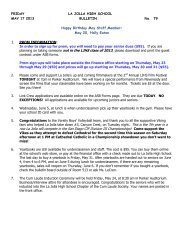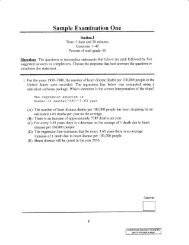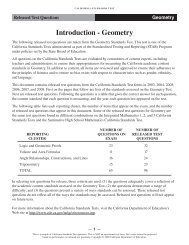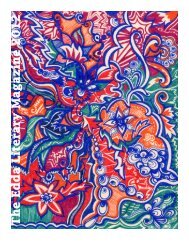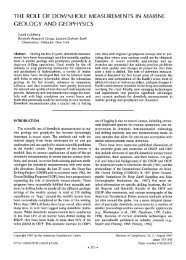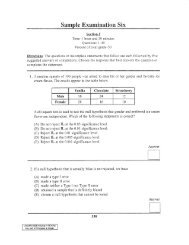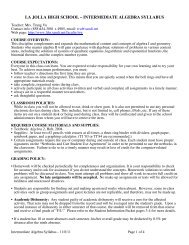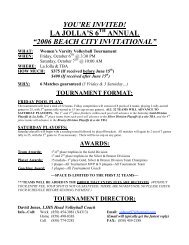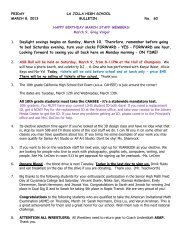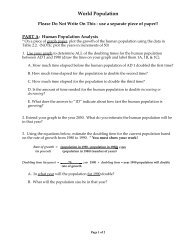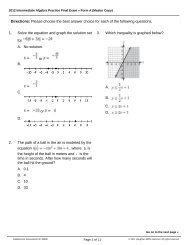Snail Lab Student
Snail Lab Student
Snail Lab Student
You also want an ePaper? Increase the reach of your titles
YUMPU automatically turns print PDFs into web optimized ePapers that Google loves.
Page 1 of 4<br />
Name:<br />
Partner:<br />
Period:<br />
The <strong>Snail</strong> <strong>Lab</strong><br />
Observations, Interpretations, and Experimental Design<br />
You will learn how to apply the scientific method during this lab. The first step is to make<br />
observations. Then you will use the question about snail mass and speed to develop a<br />
hypothesis. The fun part is making a prediction about your hypothesis. After that, you will<br />
design an experiment that will test your hypothesis. Then you will have the opportunity to<br />
analyze your data and see if your hypothesis is correct!<br />
A. Observations<br />
You may not harm the animals in any way! Working with your partner, select one snail from<br />
the <strong>Snail</strong> Hotel. Place your snail (give it a name if you wish) on a wet paper towel and gently<br />
set it on your table. Record ten good observations of your snail. Make no interpretations.<br />
1.<br />
2.<br />
3.<br />
4.<br />
5.<br />
6.<br />
7.<br />
8.<br />
9.<br />
10.<br />
<strong>Snail</strong> Mass and Speed<br />
B. Question<br />
This is the question you will be addressing: Does the mass of your snail affect the speed<br />
that it crawls?<br />
1. What are the two variables in the question?
C. Hypothesis<br />
You and your partner decide on a hypothesis for the question. A hypothesis is a statement<br />
that explains an observation. H0 is your hypothesis of no difference (no effect) – There is no<br />
effect of the independent variable on the dependent variable. HA is your alternate hypothesis.<br />
H0:<br />
HA:<br />
Variables<br />
The independent variable is the factor that is the cause. The dependent variable is the effect<br />
and is influenced by the cause. A constant variable is a factor that needs to be the same for<br />
all snails tested. Fill in the following:<br />
Independent variable:<br />
Dependent variable:<br />
Constant variable 1:<br />
Constant variable 2:<br />
Constant variable 3:<br />
D. Materials & Methods<br />
Make a list of all the materials that you will need in order to conduct the experiment.<br />
Write a detailed description of how to test the effect of snail mass on speed. The level of<br />
detail must be sufficient for someone who is unfamiliar with this lab to be able to redo your<br />
experiment from your methods. Your experiment must run for at least 10 minutes.<br />
Do not proceed with your experiment until the teacher signs off on your lab write up. NO<br />
CREDIT will be given on this assignment if you do not get my signature. I will check your<br />
work and either tell you what needs to be changed or I will sign off on it.<br />
Teacher Signature<br />
Page 2 of 4
E. Results<br />
Observations and Notes<br />
Record the following: 1) observations on what you saw, 2) ideas on how to improve the<br />
experiment, and 3) any additional comments during the experiment.<br />
Data<br />
Fill in the following table with the data collected during the experiment. Don’t forget to write in<br />
the time interval used when the snail distances are calculated (e.g., 2 minute intervals).<br />
Table 1. The distance traveled by snails for each interval<br />
<strong>Snail</strong> Mass,<br />
g<br />
<strong>Snail</strong> A<br />
<strong>Snail</strong> B<br />
<strong>Snail</strong> C<br />
Distance<br />
Travelled, cm<br />
minutes<br />
Distance<br />
Travelled, cm<br />
minutes<br />
Distance<br />
Travelled, cm<br />
minutes<br />
Page 3 of 4<br />
Distance<br />
Travelled, cm<br />
minutes<br />
Total Distance Travelled (Cumulative) = distance travelled (time 1) + distance travelled (time 2)<br />
Table 2. Total distance travelled during the experiment<br />
Time, minutes<br />
Total Distance<br />
Travelled, cm<br />
<strong>Snail</strong> A<br />
Total Distance<br />
Travelled, cm<br />
<strong>Snail</strong> B<br />
Distance<br />
Travelled, cm<br />
minutes<br />
Total Distance<br />
Travelled, cm<br />
<strong>Snail</strong> C<br />
Graph<br />
Make an XY graph (line graph) of Time and Total Distance Travelled using the data from<br />
your 3 snails. Include a title (descriptive of all variables measured and the subject organism),<br />
label the axes, indicate units (min and cm), and number the axes ticks. Include a legend<br />
that indicates which snail is graphed for each set of data points. Connect the data points for<br />
each snail with a line, starting from 0. Make sure the independent and dependent<br />
variables are on the correct axes!
F. Conclusion<br />
What is the answer to the question you set out to answer about the snails? Include the<br />
following in your paragraph:<br />
1. Restate your original hypothesis (HA).<br />
2. Write about whether or not your Hypothesis was correct or not and why – refer to your data<br />
that you collected. Use actual numbers that you measured in your experiment.<br />
3. Why do you think you got the results that you did?<br />
4. What future experiments could be done with snails?<br />
Page 4 of 4



